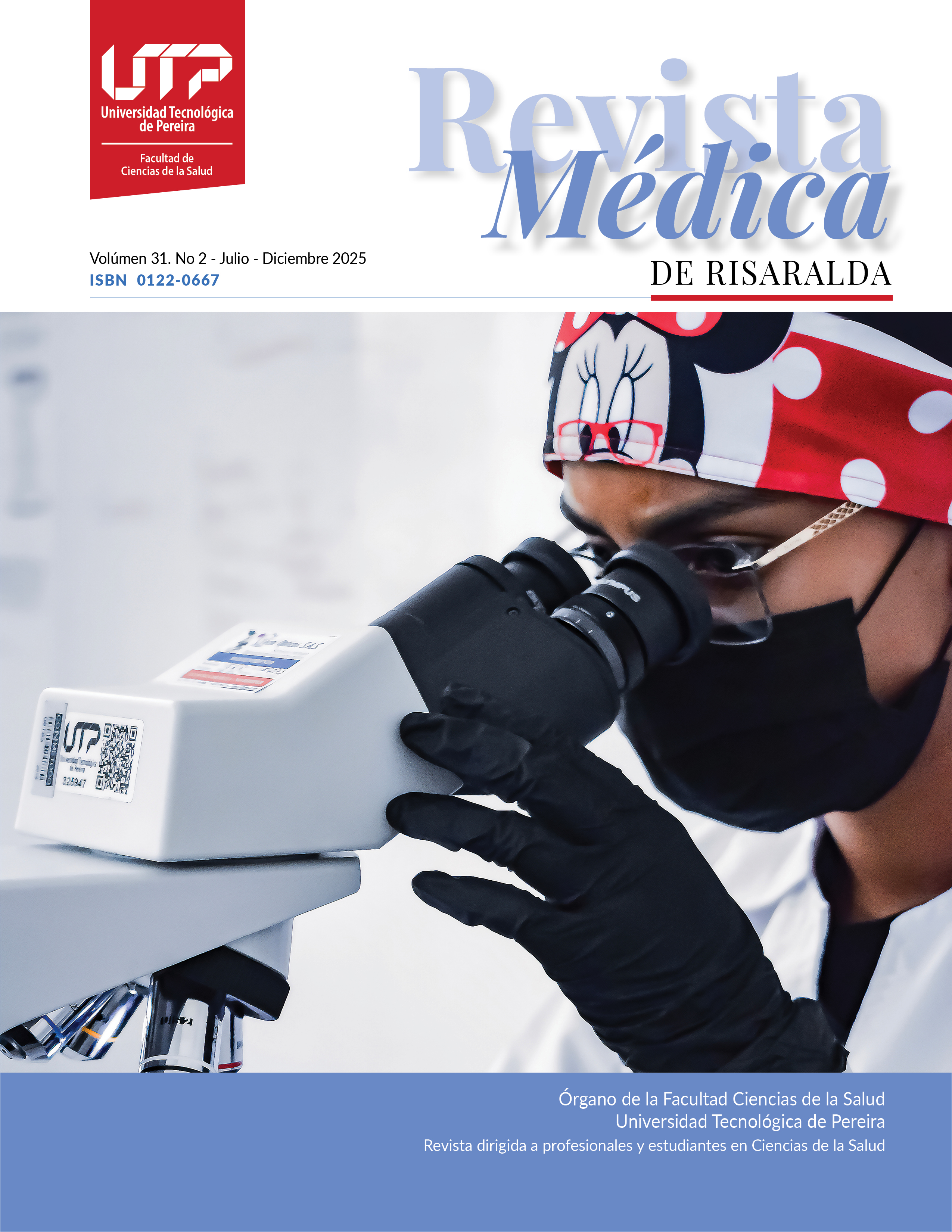Prevalence and Associated Factors of Adverse Reactions to Vancomycin in Hospitalized Patients in the Internal Medicine Department of a High-Complexity Hospital in Colombia: A Cross-Sectional Study
DOI:
https://doi.org/10.22517/25395203.25815Keywords:
Vancomycin, adverse drug reactionAbstract
Objective: Identify the prevalence of adverse reactions associated with the use of vancomycin, as well as the factors related to their severity.
Materials and Methods: A descriptive cross-sectional study was conducted on patients admitted to a high-complexity hospital in the city of Neiva who were prescribed vancomycin. A probabilistic sampling was carried out, with a review of clinical histories and a survey, the dependent variable was the presence of adverse reactions. The data obtained were recorded in Excel and analyzed using statistical software, obtaining descriptive statistics with central tendency and dispersion measures. A bivariate analysis was performed, and the Chi-square test was used to analyze two qualitative variables.
Results: A total of 104 patients, of whom 51.9% were men; skin and soft tissues were the most commonly affected sites with 39.4%. Polypharmacy, hypertension, and advanced age were the most related comorbidities. 14% of the patients presented adverse drug reactions (ADR), nephrotoxicity being the most frequent at 53.3%. 85.6% of the patients had plasma level monitoring. 38.4% of the formulations had drug interactions, Piperacillin-tazobactam being the most commonly involved (45%). The pharmacological immunosuppression had a higher probability of presenting an adverse reaction.
Conclusions: The prevalence of adverse drug reactions to vancomycin is 14%, with nephrotoxicity and hypersensitivity reactions being the most common. Severe reactions were the most frequently found, and pharmacological immunosuppression was the most related factor with the occurrence of reactions.
Downloads
References
Bruniera FR, Ferreira FM, Saviolli LRM, et al. The use of vancomycin with its therapeutic and adverse effects: a review. Eur Rev Med Pharmacol Sci. 2015;19:694–700. Available from: https://www.europeanreview.org/wp/wp-content/uploads/694-7001.pdf
Zhu Y, Huang L, Zhang J, Liang L, Jin P. Incidence and risk factors of vancomycin-induced thrombocytopenia: a six-year real-world study. BMC Infect Dis. 2025;25:7. doi:10.1186/s12879-024-10393-1
Wen Y, Chen Y, Xiao G. A rare occurrence of vancomycin-induced gastrointestinal hemorrhage without thrombocytopenia: a case report and literature review. BMC Infect Dis. 2024;24:1105. doi:10.1186/s12879-024-09949-y
Orjuela Camargo A, Caviedes Pérez G. Patrones de administración de vancomicina en pacientes críticamente enfermos. Rev Med Risaralda. 2021;27(2). doi:10.22517/25395203.24682
Ramírez Osorio JF, Vélez Hernández JE, Fernández Castaño N, Rojas Hernández DF, Jaimes F. Impact of vancomycin trough levels monitoring on uncomplicated methicillin-resistant Staphylococcus aureus bacteremia in chronic kidney disease on hemodialysis: retrospective cohort. BMC Infect Dis. 2024;24:1212. doi:10.1186/s12879-024-10107-7
Scribel L, Galiotto A, de Souza Rodrigues I, Hahn R, Linden R, Zavascki A. Comparison of vancomycin assays in patients undergoing hemodialysis. Braz J Infect Dis. 2024;28(5):103869. doi:10.1016/j.bjid.2024.103869
Chander S, Kumari R, Wang HY, et al. Effect of low vs. high vancomycin trough level on the clinical outcomes of adult patients with sepsis or Gram-positive bacterial infections: a systematic review and meta-analysis. BMC Infect Dis. 2024;24:1114. doi:10.1186/s12879-024-09927-4
Ruczynski J, Prochera K, Kaźmierczak N, et al. New conjugates of vancomycin with cell-penetrating peptides: synthesis, antimicrobial activity, cytotoxicity, and BBB permeability studies. Molecules. 2024;29(23):5519. doi:10.3390/molecules29235519
Orjuela Rodríguez T, Rojas-Cortés R, Vergara V, et al. Reacciones adversas a medicamentos utilizados para la COVID-19 en cinco países de América Latina. Rev Panam Salud Publica. 2022;46:e178. doi:10.26633/RPSP.2022.178
Dagnew SB, Moges TA, Mengie Ayele T, Agegnew Wondm S, et al. Adverse drug reactions and its associated factors among geriatric hospitalized patients at selected comprehensive specialized hospitals of the Amhara Region, Ethiopia: a multicenter prospective cohort study. BMC Geriatr. 2024;24:955. doi:10.1186/s12877-024-05515-y
Colimon KM. Muestreo y tamaño muestral. In: Fundamentos de epidemiología. Medellín: Corporación para Investigaciones Biológicas; 2010. p. 167–86.
Bidone N, et al. Prescripción y uso de antibióticos en una unidad de cuidados intensivos pediátricos de la ciudad de Buenos Aires. Arch Argent Pediatr. 2008;106(5). Available from: https://www.scielo.org.ar/scielo.php?script=sci_arttext&pid=S0325-00752008000500007
Giachetto G, et al. Uso de vancomicina en servicios de internación pediátrica del Centro Hospitalario Pereira Rossell. Arch Pediatr Urug. 2006;77(2):118–24. Available from: http://www.scielo.edu.uy/scielo.php?script=sci_arttext&pid=S1688-12492006000200007
Insani WN, Whittlesea C, Alwafi H, et al. Prevalence of adverse drug reactions in the primary care setting: a systematic review and meta-analysis. PLoS One. 2021;16(5):e0252161. doi:10.1371/journal.pone.0252161
Machado-Alba JE, Moncada-Escobar JC. Reacciones adversas medicamentosas en pacientes que consultaron a instituciones prestadoras de servicios en Pereira, Colombia. Rev Salud Publica (Bogota). 2006;8(2):200–8.
Budnitz DS, Pollock DA, Weidenbach KN, et al. National surveillance of emergency department visits for outpatient adverse drug events. JAMA. 2006;296(15):1858–66. doi:10.1001/jama.296.15.1858
Rangel CR, Rojas S, López M, Caviedes G. Prevalencia y factores asociados a la presencia de reacciones adversas a medicamentos en los pacientes tratados por medicina interna en el Hospital Universitario Hernando Moncaleano Perdomo. Rev Med Risaralda. 2016;22(2):87–90.
Beltrán C, Caviedes G. Adverse drug reactions occurring in the internal medicine service at University Hospital in Neiva. Rev Fac Salud. 2013;5(2):10–7. doi:10.25054/rfs.v5i2.137
González Delgado D, Vives M, Monedero P, Aldaz A. Uso de vancomicina y lesión renal aguda en pacientes críticos con sepsis o shock séptico: cohorte observacional retrospectiva. Rev Esp Anestesiol Reanim. 2025;72(2):501657. doi:10.1016/j.redar.2024.501657
Sales GTM, Foresto RD. Drug-induced nephrotoxicity. Rev Assoc Med Bras (1992). 2020;66 Suppl 1:82–90. doi:10.1590/1806-9282.66.S1.82
Ganesh RN, Edwards A, El Zaatari Z, et al. Vancomycin nephrotoxicity: a comprehensive clinico-pathological study. PLoS One. 2014;19(3):e0295136. doi:10.1371/journal.pone.0295136
Meaney CJ, Hynicka LM, Tsoukleris MG. Vancomycin-associated nephrotoxicity in adult patients: incidence, outcomes, and risk factors. Pharmacotherapy. 2014;34(7):653–61. doi:10.1002/phar.1423
Sinha Ray A, Haikal A, Hammoud KA, Yu ASL. Vancomycin and the risk of AKI: a systematic review and meta-analysis. Clin J Am Soc Nephrol. 2016;11(12):2132–40. doi:10.2215/CJN.05920616
Barberán J, Mensa J, Artero A, et al. Factores asociados con el desarrollo de nefrotoxicidad en pacientes tratados con vancomicina frente a daptomicina en infecciones graves por grampositivos: un estudio basado en la práctica clínica. Rev Esp Quimioter. 2019;32(1):22–30.
Huang V, Clayton NA, Welker KH. Glycopeptide hypersensitivity and adverse reactions. Pharmacy (Basel). 2020;8(2):70. doi:10.3390/pharmacy8020070
Zeng M, Wang H, Qiu H, Gao J. Oral vancomycin-induced flushing syndrome in a multiple myeloma patient: a case report and review of the literature. Medicine (Baltimore). 2024;103(47):e40640. doi:10.1097/MD.0000000000040640
Zhu LJ, Liu AY, Wong PH, Arroyo AC. Road less traveled: drug hypersensitivity to fluoroquinolones, vancomycin, tetracyclines, and macrolides. Clin Rev Allergy Immunol. 2022;62(3):505–18. doi:10.1007/s12016-021-08919-5
Purja S, Kim M, Elghanam Y, Shim HJ, Kim E. Efficacy and safety of vancomycin compared with those of alternative treatments for methicillin-resistant Staphylococcus aureus infections: an umbrella review. J Evid Based Med. 2024;17(4):729–39. doi:10.1111/jebm.12644
Minhas JS, Wickner PG, Long AA, Banerji A, Blumenthal KG. Immune-mediated reactions to vancomycin: a systematic case review and analysis. Ann Allergy Asthma Immunol. 2016;116(6):544–53. doi:10.1016/j.anai.2016.03.030
Olender A, Ślęzak W, Krzych ŁJ. Pharmacokinetic drug-drug interactions in the intensive care unit: single-centre experience and literature review. Anaesthesiol Intensive Ther. 2017;49(4):259–67. doi:10.5603/AIT.a2017.0053
Erazo Díaz MC, Gómez Aroca AM, Gómez Aristizábal AL, et al. Prevalencia de interacciones medicamentosas en el Servicio de Medicina Interna del Hospital Universitario Hernando Moncaleano Perdomo: estudio transversal. Rev Fac Salud. 2014;6(2):26–31. doi:10.25054/rfs.v6i2.161
Laporte JR, Capellá D. Mecanismos de producción y diagnóstico clínico de los efectos indeseables producidos por medicamentos. In: Laporte JR, Tognoni G, editors. Principios de la epidemiología del medicamento. Barcelona: Ediciones Científico-Técnicas; 1993. p. 95–109.
Barber KE, Bell AM, Stover KR, Wagner JL. Intravenous vancomycin dosing in the elderly: a focus on clinical issues and practical application. Drugs Aging. 2016;33(12):845–54. doi:10.1007/s40266-016-0420-z
Granowitz EV, Brown RB. Antibiotic adverse reactions and drug interactions. Crit Care Clin. 2008;24(2):421–42. doi:10.1016/j.ccc.2007.12.011
Orekoya O, Farquharson NR, Coulson IH. Cutaneous adverse drug reactions. Med (Baltimore). 2021;49(7):428–34. doi:10.1016/j.mpmed.2021.04.006
Kim JY, Yee J, Yoon HY, Han JM, Gwak HS. Risk factors for vancomycin-associated acute kidney injury: a systematic review and meta-analysis. Br J Clin Pharmacol. 2022;88(9):3977–89. doi:10.1111/bcp.15429
Downloads
-
Vistas(Views): 171
- PDF (Español (España)) Descargas(Downloads): 89
- PDF Descargas(Downloads): 20
Published
How to Cite
Issue
Section
License
Cesión de derechos y tratamiento de datos
La aceptación de un artículo para su publicación en la Revista Médica de Risaralda implica la cesión de los derechos de impresión y reproducción, por cualquier forma y medio, del autor a favor de Facultad de Ciencias de la Salud de la Universidad Tecnológica de Pereira. 1995-2018. Todos los derechos reservados ®
por parte de los autores para obtener el permiso de reproducción de sus contribuciones. La reproducción total o parcial de los trabajos aparecidos en la Revista Médica de Risaralda, debe hacerse citando la procedencia, en caso contrario, se viola los derechos reservados.
Asimismo, se entiende que los conceptos y opiniones expresados en cada trabajo son de la exclusiva responsabilidad del autor, sin responsabilizarse ni solidarizarse, necesariamente, ni la redacción, ni la editorial.
Es responsabilidad de los autores poder proporcionar a los lectores interesados copias de los datos en bruto, manuales de procedimiento, puntuaciones y, en general, material experimental relevante.
Asimismo, la Dirección de la revista garantiza el adecuado tratamiento de los datos de carácter personal



